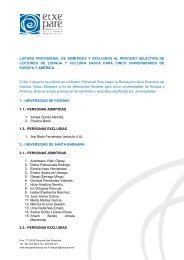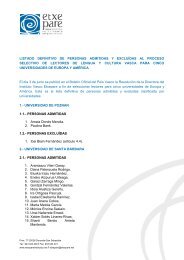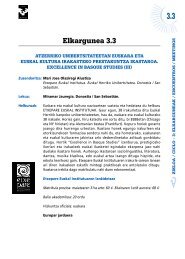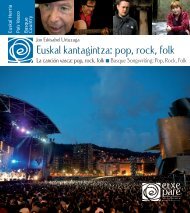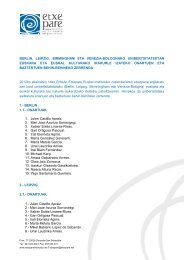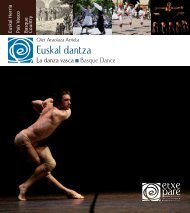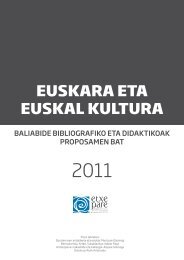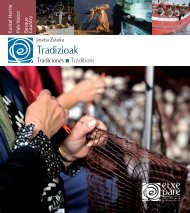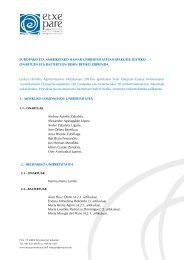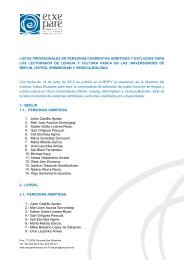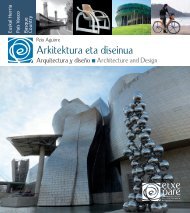XX. mendeko euskal literatura - Etxepare, Euskal Institutua
XX. mendeko euskal literatura - Etxepare, Euskal Institutua
XX. mendeko euskal literatura - Etxepare, Euskal Institutua
You also want an ePaper? Increase the reach of your titles
YUMPU automatically turns print PDFs into web optimized ePapers that Google loves.
y que se crearan ayudas a la producción en euskera.<br />
Por otra parte, en 1981 se crearon los estudios universitarios<br />
de Filología Vasca, dando un gran impulso<br />
a la investigación literaria a nivel académico. La década<br />
de 1980 fue testigo de la creación de la Asociación<br />
de Escritores (1982), de la Asociación de Traductores,<br />
Correctores e Intérpretes Vascos (1987) así como de<br />
la Asociación Galtzagorri dedicada a la promoción de<br />
la <strong>literatura</strong> infantil y juvenil en lengua vasca.<br />
Jose Irazu Garmendia, conocido como Bernardo<br />
Atxaga es, sin duda, el mejor ejemplo de la autonomía<br />
que la <strong>literatura</strong> en euskera consiguió a partir de<br />
la década de 1980. Además de ser el autor vasco más<br />
premiado y traducido, Atxaga es uno de los pocos<br />
escritores en lengua vasca que se dedica profesionalmente<br />
a la escritura. La geografía imaginaria Obaba,<br />
dada a conocer mediante la narración “Camilo Lizardi<br />
erretore jaunaren etxean aurkitutako gutunaren<br />
azalpena” (1982), ocupa un lugar estelar en la obra<br />
de Atxaga. Obaba debe su origen a una canción de<br />
cuna vizcaína, y en este espacio se desarrollan las<br />
historias recogidas en las novelas breves Sugeak txoriari<br />
begiratzen dionean (1984), Bi letter jaso nituen<br />
oso denbora gutxian (1984), Bi anai (1985) y en el<br />
conocido libro de narraciones Obabakoak (1988). La<br />
contraposición de la naturaleza a la cultura condiciona<br />
lo ocurrido en Obaba. Se trata de un mundo<br />
pre-moderno en el que no hay lugar para conceptos<br />
como el de “depresión” o “esquizofrenia”; los lugareños<br />
recurren a los animales cuando quieren entender<br />
algo que va más allá de su razón. Obabakoak es,<br />
en concreto, una colección de narraciones que guardan<br />
relación unas con otras. En todas ellas el paisaje<br />
afectivo de Obaba es un espacio virtual ilimitado en<br />
el que la memoria del narrador va tejiendo las historias.<br />
Estas historias aúnan la reflexión metanarrativa<br />
y las estrategias propias de la <strong>literatura</strong> fantástica.<br />
Este viaje fantástico es, ante todo, un viaje literario,<br />
intertextual. Obabakoak rinde homenaje a los maestros<br />
del cuento, sean los que escribieron sobre la<br />
Examples of this change are the neo-vanguard novels<br />
Zergatik bai (1976) by Izagirre and Ziutateaz (1976)<br />
by Atxaga. Both works closed the experimentalist<br />
phase of the 1970s.<br />
After the ratification of the Spanish Constitution in<br />
1978, Euskara became a co-official language with<br />
Spanish in the two peninsular Basque communities<br />
(the Basque Autonomous Community and the Foral<br />
Community of Navarre). This allowed for bilingual<br />
educational models to be offered and for grants to<br />
aid production in Euskara. Meanwhile, in 1981 university<br />
studies in Basque Philology were offered for<br />
the first time, encouraging literary research at an<br />
academic level. In the 1980s, the Association of Writers<br />
(1982), the Association of Translators, Editors and<br />
Interpreters (1987) and the Galtzagorri Association<br />
(dedicated to the production of children’s and young<br />
adult literature in the Basque language) were all established.<br />
Jose Irazu Garmendia, better known as Bernardo<br />
Atxaga is, without any doubt, the best example of<br />
literature in Euskara managing to produce an autonomous<br />
writer in the 1980s. Besides being the most<br />
prizewinning and translated Basque author, Atxaga is<br />
one of the few full-time writers in the Basque language.<br />
The imaginary geography of Obaba, which appeared<br />
for the first time in “Camilo Lizardi erretore<br />
jaunaren etxean aurkitutako gutunaren azalpena”<br />
(1982), occupies a stellar place in Atxaga’s work.<br />
Obaba owes its origins to a Bizkaian lullaby, and it is<br />
here that the stories contained in the short novels<br />
Sugeak txoriari begiratzen dionean (1984), Bi letter<br />
jaso nituen oso denbora gutxian (1984; Two Basque<br />
Stories, 2009) and Bi anai (1985; Two Brothers,<br />
2001), as well as his book of short stories Obabakoak<br />
(1988; published in English in 1992), take place. 3 The<br />
3<br />
Where an English-language translation of a work cited has<br />
been published, its title and initial year of publication will<br />
be given.<br />
25



